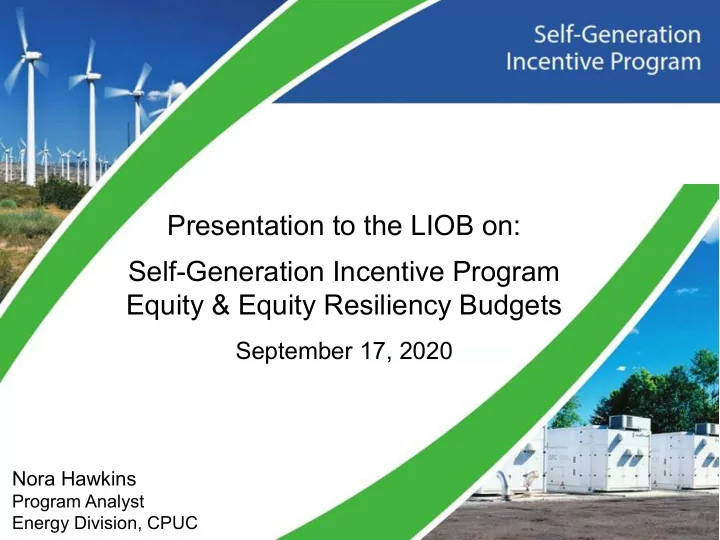

Presentation to the LIOB on: Self-Generation Incentive Program Equity & Equity Resiliency Budgets September 17, 2020 Nora Hawkins Program Analyst Energy Division, CPUC 1
Self-Generation Incentive Program (SGIP) • Initiated 2001; longest running incentive program in U.S. • Any retail electric or gas distribution class of customer (industrial, agricultural, commercial or residential) of PG&E, SCE, SoCalGas, or SDG&E is eligible to be the Host Customer and receive SGIP incentives. • Administered by PG&E, SCE, SoCalGas, and Center for Sustainable Energy (CSE) on behalf of SDG&E. 2
Bringing Equity into SGIP • Decision D.17-10-04 adopted October 12, 2017 ‒ “Equity Decision” ‒ Directed 25% of funds for distributed energy storage to low income households and environmentally burdened communities as well as state and local government agencies, educational institutions, non- profits, and small businesses. ‒ Capped equity budget incentives at $0.50/Wh. ‒ Essentially no uptake 2017-2019 No Marketing, Education, & Outreach (ME&O) budget Incentives likely too low 3
Recent Changes to Support Equity Customers • D.19-09-027 adopted 9/12/19 - “Equity Resiliency Decision” – Increased equity incentives to $0.85/Wh – Created new equity resiliency budget to support vulnerable customers facing increased risks of wildfires • D.20-01-021 adopted 1/16/20 - “SB 700 Decision” – Adopted annual funding level of $166 million for 2020 through 2024, creating a total budget for equity resiliency of $612 million – Modified program rules to include additional vulnerable customers and address de-energization events • D.20-07-015 adopted 7/16/20 - Decision on CALSSA’s PFM ‒ Modified D.19-09-027 to clarify equity budget eligibility for residential customers in California Indian Country ‒ Confirmed single-family equity applicants must demonstrate that they don’t exceed 80% AMI via income documentation 4
SGIP Storage Equity Budgets (separate budgets for residential and non-residential) Funding: All funding currently allocated. Incentive: $0.85/watt-hour (Wh). Eligibility Residential customers living anywhere in IOU service territory residential: but must reside in a qualifying multi-family residential deed- restricted building or a single-family home subject to resale restrictions or presumed resale restrictions and household income must be ≤ 80% area median income. Eligibility Located in top 25% Disadvantaged Communities (DACs) non- including all CA Indian Country, or in low-income community residential: (median income ≤ 80% AMI) and: Is a non-profit, small business, educational institution, or local/state agency ≥ 50% of census tracts served are DACs. 5
SGIP Equity Resiliency Storage Budget (same budget for residential non-residential) Funding: $612M through 2024, ~ $300M still available. Incentive: $1.00/watt-hour (Wh). Covers ~full cost of residential projects. Supports Longer duration energy storage allowed, requires that systems resiliency: are capable of islanding. Locational All participants must be in High Fire Threat District (HFTD) Tier eligibility: 3 or Tier 2; or had electricity shut off during 2 or more Public Safety Power Shutoff (PSPS) events. Residential: Eligible for equity budget, medical baseline, have condition that’s life threatening if disconnected, rely on electric well pump, participant in SASH, DAC-SASH, MASH, or SOMAH. Non- Provide critical facilities/infrastructure to Tier 3 or 2 HFTD Residential: community eligible for equity budget. Police/fire stations; emergency response; medical facilities; public & private gas, electric, water, wastewater or flood control facilities; locations designated by IOUs to provide assistance during PSPS; foodbanks; independent living centers etc. 6
CPUC Actions to Support Customers Participation in SGIP • Created a customer-facing website with accessible information – brochures, find an installer, etc.: https://www.cpuc.ca.gov/sgipinfo/ • Adopted Resolution E-5086 approving PG&E’s financial assistance pilot and creating a customer recruitment incentive for CBOs modelled after the CARE Capitation Program 7
SGIP Mapping Tool Created by CPUC to Help Customers Explore Potential Eligibility • As noted on website, maps do not confer eligibility and are for informational purposes only. Eligibility will continue to be determined by the SGIP PAs. 8
SGIP Resources • Statewide program page: https://www.selfgenca.com/ • CPUC website for customer facing information: https://www.cpuc.ca.gov/sgipinfo/ • CPUC Docket for recent decisions in Docket R.12-11-005: https://apps.cpuc.ca.gov/apex/f?p=401:1:0 • New SGIP proceeding: Docket R.20-05-012: https://apps.cpuc.ca.gov/apex/f?p=401:57:0::::: • CPUC point of contact: – Nora Hawkins, Lead SGIP Analyst in the Energy Division – Telephone: 415-703-3306 or Email: Nora.Hawkins@cpuc.ca.gov 9
Recommend
More recommend